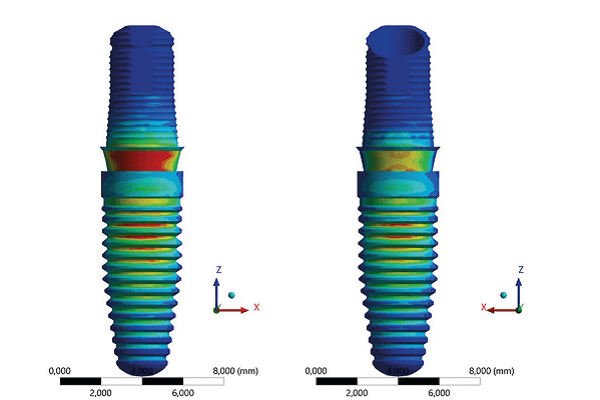RESUMO
Objetivo: avaliar a carga para fratura e a distribuição de tensões através de uma análise de elementos finitos (FEA) de um novo pilar cônico modificado. Material e métodos: dez implantes cone-morse com plataforma 3,5 e os respectivos pilares EsthetiOne (EFF Dental Componentes), esses conjuntos foram montados e incluídos em uma base de resina de poliuretano em duas situações: nível ósseo e 3 mm aquém do nível ósseo. Foi realizado o ensaio de carga para fratura em uma máquina de ensaios universal, os dados foram registrados e analisados estatisticamente. Os desenhos dos conjuntos implante-pilar-coroa foram montados e em seguida analisados por elementos finitos no software Ansys (FEA). Todos os contatos foram considerados colados e fixados na resina (simulando completa osseointegração). Em seguida, uma carga oblíqua de 200 N foi aplicada na superfície palatina das coroas. Os critérios de análise foram: a tensão de von-Mises e o deslocamento total. Os mapas de tensão foram plotados em gráficos colorimétricos. Resultados: houve maior carga para fratura dos conjuntos montados a nível ósseo do que aqueles instalados com 3 mm expostos (teste t, p < 0,05). Já a FEA indicou maior tensão na região vestibular do pilar em ambas as instalações do implante, devido à compressão. Na amostra com 3 mm expostos, notou-se maior tensão na região do implante e do parafuso protético. Conclusão: o pilar EsthetiOne é adequado clinicamente, com benefícios na distribuição de tensões, especialmente quando instalado ao nível ósseo.
Palavras-chave – Implantes dentários; Prótese Dentária; Design de pilar de implante dentário.
ABSTRACT
Objective: to evaluate the fracture load and stress distribution through a Finite Element Analysis (FEA) of a new modified conical abutment. Material and methods: 10 cone morse implants with a 3.5 platform and the respective EsthetiOne abutments (EFF Dental Componentes), were assembled and included in a polyurethane resin base in two situations: bone level and 3 mm below bone level. The fracture load test was carried out on a Universal testing machine, the data was recorded and statistically analyzed. The designs of the implant-abutment-crown were assembled and then analyzed using Finite Elements in the Ansys software (FEA). All contacts were considered glued and fixed in the resin (simulating complete osseointegration). Then, an oblique load of 200 N was applied to the palatal surface of the crowns. The analysis criteria were: von-Mises stress and total displacement. The stress maps were plotted on colorimetric graphs. Results: a greater fracture load was seen for assemblies mounted at bone level than those installed with 3 mm exposed (T test, p < 0.05). The FEA indicated greater tension in the vestibulary region of the abutment in both implant installations, due to compression. In the sample with 3 mm exposed, greater tension was noted in the region of the implant and prosthetic screw. Conclusion: the EsthetiOne abutment is clinically appropriate, with benefits in stress distribution, especially when installed at bone level.
Key words – Dental implants; Dental prosthesis; Dental implantabutment design.
Referências
- Ankita P, Mithilesh MD, Seema S, Smruti G. Effectiveness, esthetics, and success rate of dental implants in bone-grafted regions of cleft lip and palate patients: a systematic review and meta-analysis. Cureus 2023;15(11):e49101.
- Isidor F. Influence of forces on peri-implant bone. Clin Oral Implants Res 2006;17(suppl.2):8-18.
- Alevizakos V, Bergmann AL, von See C. Removal of broken abutment screws using ultrasonic tip – a heat development in-vitro study. BMC Oral Health 2024;24(1):2.
- Camargos GV, Sotto-Maior BS, Silva WJ, Lazari PC, Del Bel Cury AA. Prosthetic abutment influences bone biomechanical behavior of immediately loaded implants. Braz Oral Res 2016;30(1):S1806-83242016000100901.
- Mesquita AMM, Silva JHM, Saraceni CHC, Kojima AN Özcan M. Effect of different abutments and connections in deformation crestal bone. Implant Dent 2016;25(3):328-34.
- Degidi M, Daprile G, Piattelli A. Marginal bone loss around implants with platform-switched Morse-cone connection: a radiographic cross-sectional study. Clin Oral Implants Res 2017;28(9):1108-12.
- Hickey JC, Kleider JA, Boucher CO, and Stroz O. A method of studying the influence of occlusal schemes on muscular activity. J Prosthet Dent 1959;9(3):498-506.
- Magalhaes BCB, Pedroso A. One abutment one time: uma nova perspectiva de reabilitação oral. Braz J Develop 2023;9(3):9102-23.




